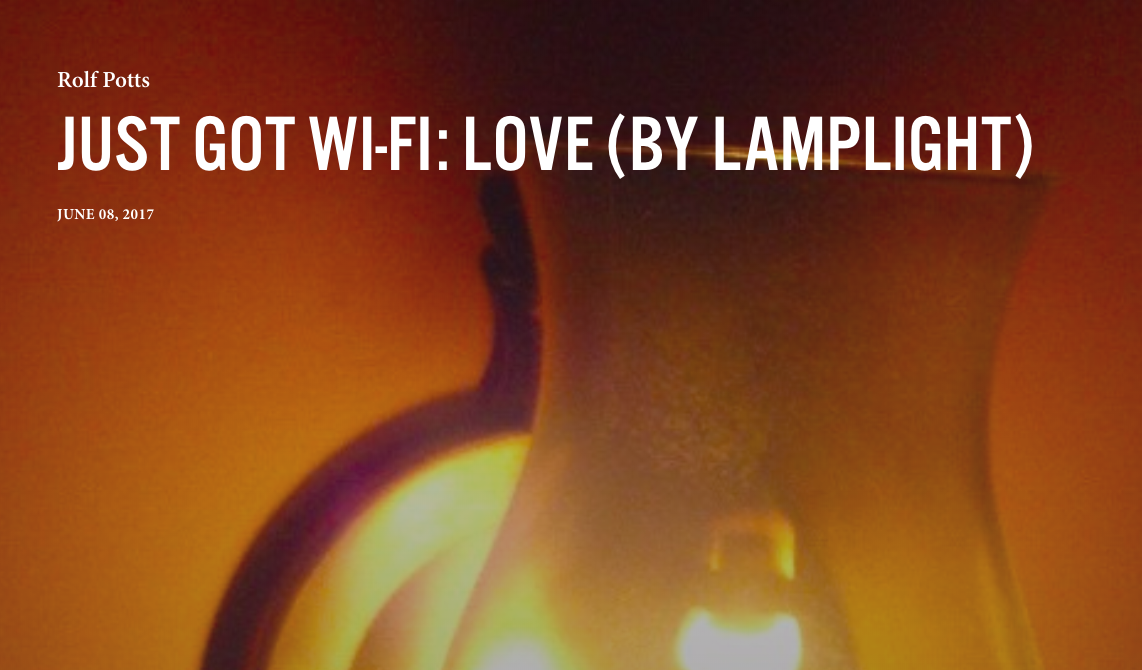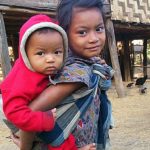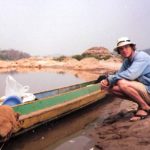You’ve just arrived in Cairo. Before you write your story, you can’t resist writing to a friend, your beloved, your mom. “Just Got Wi Fi” is devoted to the letters that travel writers pen during their earliest hours in alien lands. We send you a letter penned from many worlds and time zones away. We hit up vagabonding legend (and author of, um, Vagabonding) Rolf Potts. Rolf just happened to have a trove of love letters on hand, penned by lamplight in Laos.
November 12, 2000
Na Village
DEAREST STEFIE,
It is night, and I am writing to you by the light of an oil lamp in Na village—which has to be one of the most remarkable places I’ve ever been. We arrived here yesterday afternoon, via a cave about 6 kilometers from the Hinboun River. You almost have to see this valley to believe it—it is completely surrounded by mountains, and the only entrance is through the cave. At the height of the rainy season, Na village is completely isolated from the rest of the world. The floor of the valley must be 25 square kilometers, and being inside it feels like being inside a volcano, but of course there is no volcano— just limestone mountains. The cave (I don’t know its name) drains the valley.
We hiked through yesterday with a team of porters from Phahang village—teenage boys who work for $1.50 a day, which is an excellent wage in this part of Laos. The porters would have cost about 85 cents a day, but Mr. Kham did the negotiating. Max thinks Mr. Kham is keeping part of the extra for himself, and I’d have to agree. The good news is that little Mr. Kham is starting to get tired of all the hiking, and there is no whiskey for him (or anyone) in this strange valley.
We came through the cave with the porters yesterday—sometimes hiking through waist-deep water, sometimes climbing over rock piles. In places, there are sandbars in the cave, and niches in the walls where the villagers have builtres or set torches over the years. There are small pink bamboo plants growing on some of these sandbars, though I have no idea where they get their light from. The water at the mouth of the cave is crystal clear, and we all took a bath there. I like bathing Thai-style (or, that is, Lao-style; I also bathed that way in Cambodia)—standing in the stream with a sarong and soaping up in the mid-day sun. It’s cold and scenic and it gives you energy. Once you hike through the cave, it’s about 30 minutes to Na—the only village in the entire valley.
About 200 people live there, and the place is full of kids. I am surrounded by children as I write this; they are fascinated by the simple act of writing. I’ve taken lots of pictures, and someday I’ll send you some. I’m trying to teach all the kids to count to ten in English, but I haven’t had much success yet. They love to yell out numbers after me, but they always forget when I quiz them. Max has a digital camera and laptop computer, so he is just as popular as me. Because of the cave and isolation, the only outside goods here are clothes, and a few tools and utensils. Besides Max and me, only one foreigner has visited this valley since the Vietnam War era.
About 40 minutes from Na village is a ruined temple made from bricks and mortar. The jungle has almost completely enveloped it, and only one fluted column is left standing. It was amazing when a couple of the villagers took me there this afternoon—like stumbling through the jungle into a secret, like Henri Mouhot when he rediscovered Angkor Wat in the 1860s. This site is much smaller, of course, but still amazing. The villagers call it Meung A-Lan, which means the city (as opposed to the village) of A-Lan, and say it’s 2,000 years old—older than Vientiane. I wouldn’t be surprised if the settlement this valley were thousands years old, but these ruins— with their brick-and-mortar styling—don’t seem to be any older than 200. Still, it’s amazing to find the old temple here in the jungle.
The odd thing is that, while these ruins are Buddhist in form, the Na villagers are animist in habit. Nobody has any Buddhist habits; the kids all wear herbs on their necks to ward off the spirits, and the only request when Max and I entered the village was to buy a pig to sacrifice to the spirits of the valley (though I have yet to see any pig, so perhaps Mr. Kham kept the money). I will have to investigate the history of these ruins more once I get back to Thailand.
Stefie, the kids are still packed around me here in the headman’s hut and I can hardly see by the light of this oil lamp, but I’ll try to go on, because I want to try and convince you to come and meet me in Burma or Nepal sometime this spring. That is, instead of going to Argentina with Nele. And I know that Nele is persuasive, but isn’t there any way I can be more persuasive? And haven’t you always wanted to see the mighty Himalayas? And if you came out for two weeks in Nepal, I’ll promise to come out for two months in Brussels. Deal?
One last thing. I was hiking in the rice fields of the valley this morning, so happy to be out in the sun in such a quiet place. And I know it’s an absurd thought, but I was thinking about how happy I’d be in that valley if I just had a wooden chair, a plastic table, some cheese, some fruit, and you there with me. A badge for your chest from the Valley of Na.
Love (by lamplight),
ROLF
***
EPILOGUE: Stefie was a moody, doe-eyed Belgian jewelry designer I’d met in southern Thailand. I didn’t know her that well, but I was smitten. In a sense I was writing letters to a hypothetical version of who I thought Stefie might be, and testing out a romanticized version of who I thought I might be. The letter is framed with an allusion to an oil lamp, but I’m pretty sure I didn’t really write it by lamplight; I think I just liked the haunting glow of the oil lamps after dark, and I wanted to convey what it felt like to sit in the dim radiance of that isolated valley.
This is one of a dozen letters I wrote to Stefie in the jungles of Laos, and while she never took me up on my offer to meet in Burma or Nepal, she did inviteme to visit her in Brussels.I arrived in Belgium on a frigid December day, andour relationship imploded almost immediately. The last thing I did upon leaving her apartment for theairport was take back the letters I’d written her from Laos. In a way those letters embarrassed me; I felt like I’d written them to a person who didn’t fully exist outside the naive reveries of my own imagination.
I’d gone to the Na Valley to report for Condé Nast Traveler, and it was my first major magazine assignment. I had just turned 30, and it felt like my life was finally measuring up to my dreams of what it could be. The story did run in Traveler, eventually, and peppered through that 5,000-word feature, “The Hidden Valley,” are many of the details I’d captured for Stefie, and found again when I got my letters back.





